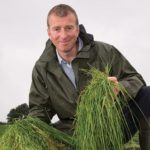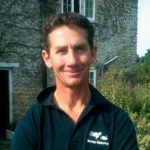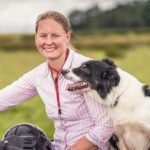Grass Watch: Wet weather leads to housing in some areas
It’s a real mixed bag this October, with Sam Chesney in Northern Ireland and Alice Muir in Scotland reporting wash outs, but Mike Miller in Dorset says that autumn has turned dry on his farm.
Looking back at the year, after a strong spring showed promise for grass, a wet summer caused many difficulties. Our columnists are now turning their attention to making sure the grazing platform goes into winter in optimum condition, so they are ready for an early spring turnout.

Robert Craig © John Eveson
Robert Craig, Penrith, Cumbria
- Land: 210ha
- Stock: 430 New Zealand/Kiwi-cross cows
- Altitude: Ranges from 160-210m above sea level
- Calving: Spring calving
The challenging end to the 2017 season continues through October, with more rain than necessary making grass use difficult.
A higher overall stocking rate at Cairnhead means cows have been housed at night a couple of weeks early and now, in mid-October, with average covers low, it is beginning to look like a long winter ahead.
We should still manage to graze days into November, but growth and ground condition will dictate for how long.
After what looked like the best spring for years, 2017 has struggled to be even average and deliver on the grass front. Milk production is holding up reasonably well, although with the help of silage and additional concentrates – just as well the milk price allows it.
Youngstock will continue to graze of the milking platform for November and hopefully most of December, avoiding eating everything, which will affect the start to the 2018 season.
|
Stocking rate on grazing platform (cows a hectare) |
3.28 |
|
Growth rate on platform (kg DM/day) |
35 (11 October) |
|
Average farm cover (kg DM/ha) |
2,198 (11 October) |
|
Yield (litres a cow a day) |
17.5 |
|
Fat (%) |
4.86 |
|
Protein (%) |
4.00 |
|
Milk solids (kg a cow) |
1.55 |
|
Supplements fed (kg a cow a day) |
4, plus 9kg DM silage |
|
Average rainfall (mm) |
66, up to 17 October |
|
Land type |
Free-draining sandy loam |
See also: What to consider before keeping sheep on tack

Richard Fryer
Richard Fryer, Northwich, Cheshire
- Land: 127ha
- Stock: 230 Friesian cows plus 120 youngstock
- Altitude: 40m
- Calving: Autumn block calving, mainly grass based
Continuing wet weather meant our cows were housed at night on 30 September – very early for us.
They have settled well and are on second-cut silage and 5kg DM of grazed grass a head during the day. At that rate, we will have enough grass until about the first week of November, which is when we normally house the cows to ensure they are settled for the start of serving on 23 November.
Ground conditions did improve enough in mid-October to get the last of the slurry out and take a fifth cut of silage, which we made into bales.
Some of the off-lying ground has been set up to keep the bulling heifers and bulls on, which should last them until Christmas. With an eye on next spring we are keen to avoid any poaching and ensure the farm is all set for an early turnout – hopefully.
|
Stocking rate on grazing platform (cows a ha) |
5 |
|
Growth rate on platform (kg DM/day) |
48 |
|
Average farm cover (kg DM/ha) |
2990 |
|
Yield (litres a cow a day) |
25 |
|
Fat (%) |
4.5 |
|
Protein (%) |
3.4 |
|
Milk solids (kg a cow) |
1.9 |
|
Supplements fed (kg a cow a day) |
7 |
|
Average rainfall (mm) |
32mm, up to 17 October |
|
Land type |
Medium |

Mike Miller
Mike Miller, Blandford, Dorset
- Land: 106ha
- Stock: 420 NZ Suffolk-cross Mules and 100 NZ Romney ewes
- Altitude: 100m above sea level
A wet start to the autumn fortunately turned dry for us in the South, and fears of an early housing of cattle were alleviated.
With mild conditions, grass growth has remained strong, ideal for tupping, and it is providing a good amount of deferred grazing.
Entering the winter period, we will ration grass for a large group of ewes into four day shifts concentrating on the lambing paddocks first, aiming to give all paddocks at least a two-month break and leave enough residue to maximise any winter growth.
A strong swede crop will help us achieve this, along with a good supply of forage if the winter turns hard and long.
|
Cows or ewes a hectare |
1.1 |
|
Growth rate (kg DM/ha) |
41 |
|
Average farm cover (kg DM/ha) |
2,675 |
|
Land type |
Heavy clay |
|
Rainfall (mm) |
17 (to date) |

Ben Richards
Ben Richards, Helston, Cornwall
- Land: 146ha
- Stock: 280 Jersey-cross Friesians
- Altitude: 110m above sea level
- Calving: Spring-calving
Dare I say it is a bit drier. I minimised any damage through August and September with on/off grazing. This is paying off now with strong growth and easier grazing (without pugholes).
This coincides with a small seasonality increase for September and October. Because of this, I will feed more pasture during October, relying more on silage in November.
By doing this I can ensure residuals are correct when ground conditions are better, thus minimising pugging on the last round and leaving the farm in good order for spring.
My empty rate was still a bit on the high side this year (7.5% compared with my target of less than 5%), but the herd is calving as tight (85%+ in three weeks) and all bar five of the 18 empties would have been culled anyway.
Last year was the first of selective dry cow therapy and I only treated 40 out of the 220 dried off. This season has seen less clinical infection and lower somatic cell counts than previous years of blanket treatment. At present we are running at about 180,000 cells/ml with 90% of the herd in milk.
This year I will only treat quarters that have been infected in this lactation. All the others will receive no DCT or teat seal.
I have made the decision to stop vaccination, so just a fluke drench and pour-on wormer to purchase.
Overall this year has been good for growth (>14t/ha) although the wet has been a bit depressing for me and the cows.
Changing my wintering system, bringing youngstock home, developing a new farm and introducing herbs, have all kept me busy. I have an apprentice on board (also my nephew), so my workload should be less for next year.
|
Stocking rate on grazing platform (cows a ha) |
2.8 |
|
Growth rate on platform (kg DM/day) |
50 |
|
Average farm cover (kg DM/ha) |
2,720 |
|
Yield (litres a cow a day) |
8 |
|
Protein (%) |
4.8 |
|
Fat (%) |
6.5 |
|
Supplements fed (kg a cow a day) |
2 (red clover silage – self-feed clamp) |
|
Rainfall (mm) |
30 (up to 16 October) |
|
Land type |
Free-draining sandy loam |

Alice Muir
Alice Muir, Buccleuch Estates, Scotland
- Land: 7,085ha, mainly heather hill with 400ha of permanent grassland
- Stock: 1,560 Blackface ewes, 1,100 Scottish Country Cheviot ewes, 900 Greyface/Aberfield ewes and 50 Galloway cows
- Altitude: 80-404m
The rainfall in the area hasn’t eased up over the lpst month. The ground type lends itself to saturation and the fields are very saturated now.
Lamb sales haven’t been as good as in previous years, although we did have more lambs at marking than normal.
We really need to start thinking about reducing our stock numbers in order to flush the ewes before tupping and try to save the ground as much as possible until the ewes are housed.
We are lucky because we managed to get our silage finished in August, and even though we may not have as much as we would like, there are some neighbours who are still waiting to attempt a second cut, which is looking more unlikely now as the rain hasn’t stopped this past week.
Our slight lack of silage means we would like to try to keep the ewes outside as long as possible, but with the ground conditions, it seems likely they will be housed before Christmas to preserve the ground for turnout in April.
The ewes are fit in general, but the weather isn’t helping to fatten lambs – fingers crossed it dries up soon.
Ideally, in future we would like to start our rotation earlier, and keep it going for longer. In a normal year I think this would be achievable and allow us to save dry areas for this time of year when grass growth is slowing and we need to buffer the ewes before tupping.
|
Cows or ewes a hectare |
Average 8.8 |
|
Growth rate (kg DM/ha) |
20 (estimate as measurement has stopped) |
|
Average farm cover (kg DM/ha) |
1,650 |
|
Land type |
Peat/clay |
|
Average rainfall (mm) |
94 (up to 13 October) |

Sam Chesney © Steffan Hill
Sam Chesney, Kircubbin, County Down
- Stock: 150 Limousin sucklers
- Altitude: 30m above sea level
Batten down the hatches is the word from Northern Ireland as I write this – we are expecting an ex-hurricane for tea and Ireland is on red alert.
Grass this month has been difficult to graze. We housed and weaned all cattle and have now turned all heifer calves and a few steers out to graze some dryer paddocks at about 5,000kg/ha, but we are moving them every other day.
The poor weather in August and September has cost me about 50-60kg a head of liveweight.
Sheep are all grazing, out in paddocks further from the yard, and the first draw of lambs I bought go this week.
Average grass results from across Northern Ireland this week show growth at 22.5kg/ha, with a dry matter of 13.5%, metabolisable energy of 10.9 MJ and crude protein of 21.9. However, as always, it’s ground conditions that have beaten most of us.
Farmers in Northern Ireland have struggled with silage, harvest and emptying slurry tanks. I am looking forward to spring 2018 – it can’t be much worse.
|
Growth rate (kg DM/ha) |
22.5kg/ha (Northern Ireland average) |
|
Land type |
Medium/heavy |
Plan ahead to improve pasture performance
Gareth Davies, independent grassland expert
This is the final Grass Watch for 2017, so I thought it would be a good time to highlight some of the planning required throughout the year to improve your farms pasture performance.
August: I always start my season in August – it is at this time of the year that you start planning a key target, and that is to get as much high-quality grass available as possible towards mid/end September. Everything else works off this target being achieved.
October: In October you start planning the last grazings of the farm, and at all times you have an eye on next year. If you want to get out early next spring you need to have grass to graze, so decide which fields you will turn out onto first and close them up first in autumn.
Spring: In the spring, the key is to graze as early as possible – this will stimulate the plant to grow. Aim to graze the entire farm by about mid-April (including silage ground). This should set the farm up for the rest of the summer.
The other vital element is rotational grazing – it works. Just do it.
